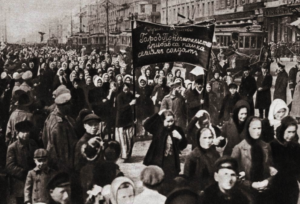International Women’s Day is celebrated on 8 March each year as a day to commemorate the struggles of the women’s rights movement.
While the first observance of Women’s Day took place on 28 February 1909 in New York, 8 March was proposed by the 1910 International Women’s Conference to establish an “International Women’s Day”.
After women won the right to vote in Soviet Russia in 1917, March 8 was established as a national holiday there.
At that time it was celebrated primarily by the socialist movement and communist countries until its adoption in 1975 by the United Nations.
History
The first observance of “Women’s Day” was called “National Women’s Day” and was held on February 28, 1909 in New York City, where it was organised by the Socialist Party of America at the suggestion of Teresa Malkiel.
Although there have been claims that the day celebrated the protest of women garment workers in New York City on March 8, 1857, researchers debunk them as myth.
On August 19, 1910, an International Women’s Conference was held as a precursor to the general meeting of the Second International Socialist Community in Copenhagen, Denmark.
Inspired in part by the American socialists, the German socialist Louise Chits proposed the establishment of an annual International Women’s Day and was supported by fellow socialist and later communist leader Clara Chetkin, seconded by Kate Duke, but no specific date was set.
The delegates (100 women from 17 countries) agreed on the idea as a means of promoting equal rights, including the right to vote for women.
The following year, on 19 March 1911, International Women’s Day was marked for the first time with the participation of over a million people in Austria, Denmark, Germany and Switzerland.
In the Austro-Hungarian Empire alone there were 300 demonstrations.
In Vienna, women marched in the Ringstrasse and raised banners to honour the martyrs of the Paris Commune.
The women demanded that they be given the right to vote and hold public office.
They also protested against gender discrimination at work.
Americans continued to celebrate National Women’s Day on the last Sunday in February.
In 1913, Russian women designated their first International Women’s Day on the last Saturday in February (according to the Julian calendar subsequently used in Russia).

Women’s protest for bread and peace – March 8, 1917, Petersburg, Russia
Although there were some strikes, marches and other protests by women in the years leading up to 1914, none of them occurred on March 8.
In 1914, International Women’s Day took place on 8 March, probably because the day was a Sunday, and since then it has always been observed on that date in all countries.
The observance of the Day in Germany in 1914 was dedicated to women’s suffrage, which German women finally obtained in 1918.
In London, a march was held from the Bow to Trafalgar Square in support of women’s suffrage on 8 March 1914. Sylvia Pankhurst was arrested in front of Charing Cross station on her way to speak in Trafalgar Square.
On March 8, 1917 (according to the Gregorian calendar), in the capital of the Russian Empire, Petersburg, women textile workers demonstrated, filling the streets of the entire city.
This marked the beginning of the Russian Revolution.
Women in St. Petersburg went on strike that day for “Bread and Peace” – demanding an end to World War I, an end to food shortages and an end to tsarism.
Leon Trotsky wrote that “February 23 (March 8) was International Women’s Day and there were meetings and events.
But we did not imagine that this ‘Women’s Day’ would herald the beginning of the revolution.
There were revolutionary actions but without a specific date.
In the morning, despite the orders they had received, the women textile workers abandoned their work in the various factories and sent delegates to ask for support for the strike … which led to a mass strike … everyone took to the streets.”
Seven days later, the Emperor of Russia, Nicholas II resigned and the provisional government granted women the right to vote.
After the October Revolution, Bolshevik Alexandra Kollontai and Vladimir Lenin designated February 23 (March 8) as an official holiday in the Soviet Union, but it continued to be a working day until 1965.
On May 8, 1965, by decree of the USSR Presidium of the Supreme Soviet, International Women’s Day was declared a non-working day in the USSR “to celebrate the extraordinary achievements of Soviet women in communist construction, in defense of their homeland during the Great Patriotic War, in heroism and selflessness at the front and in the rear, and also marking the great contribution of women in strengthening friendship between peoples and the struggle for peace.
Mitsotakis to the EPP: No border change can be tolerated by Europe – Watch his speech
Thus, Women’s Day should be celebrated like other public holidays.”
Since its official adoption in Soviet Russia after the 1917 revolution, the day has been celebrated mainly in communist countries and by the communist movement worldwide.
It began to be celebrated by the communists of China from 1922.
After the founding of the People’s Republic of China on October 1, 1949, the State Council declared on December 23 that March 8 was designated as an official holiday, with women in China entitled to a half-day off
The United Nations began celebrating International Women’s Day on International Women’s Year 1975. In 1977, the United Nations General Assembly called on member states to declare March 8 as UN Women’s Rights and World Peace Day.

In the United States, actress and human rights activist Beata Pozniak worked with the Mayor of Los Angeles and the Governor of California to persuade members of the US Congress to propose official recognition of the holiday.
In February 1994, a bill was proposed by Maxine Waters with the support of 79 members of Congress in an effort to officially recognize March 8 as a holiday.
The bill was subsequently reported and remained in the House Committee on Postal and Civil Service. No vote was taken in any chamber of Congress.
As of 2019, International Women’s Day is celebrated as a holiday in the federal state of Berlin, Germany.
Ask me anything
Explore related questions





